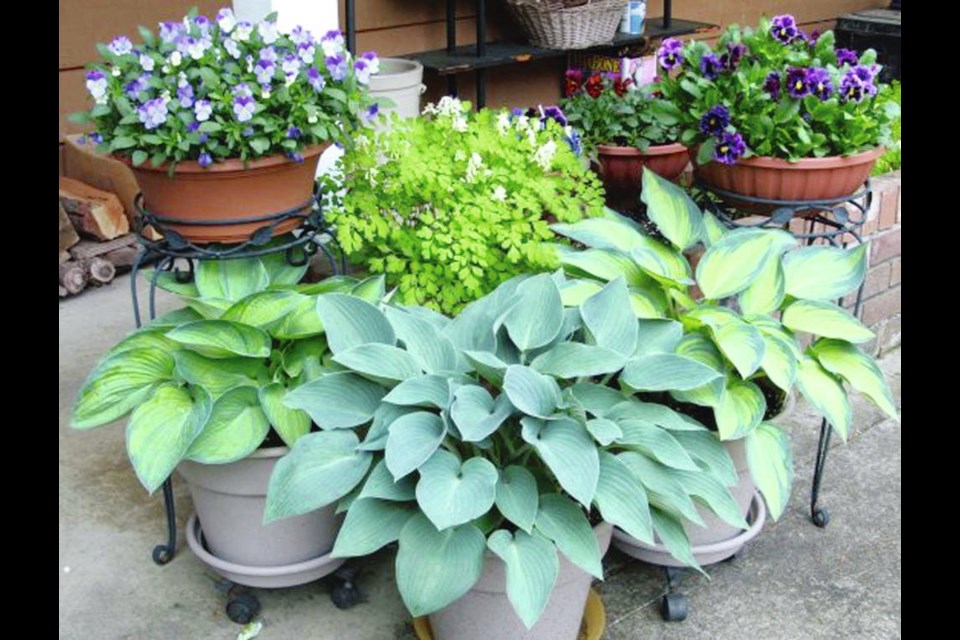Dear Helen: I have a balcony garden with potted jasmines, a Hyde Hall clematis, and hostas. I’ve noticed signs of life in the clematis. Should I water it? Should I be watering the jasmines through the winter? I’m sure the vines are pot-bound, though they do well. Of the three hostas, one has died and the other two have struggled and are in decline. The balcony faces south-west but has limited light because of a privacy trellis and the building design.
B.L.
If your balcony, and the pots, are open to the fall and winter rains, the hostas would benefit from being moved late in the fall against a wall, out of the rain, to avoid their becoming waterlogged and rotting. If the balcony is covered, water potted plants minimally through the winter, just enough to keep the soil from drying out.
Most hostas do well in pots over four or five years as long as they are kept adequately watered in dry weather and not over-watered, or left out in the rain all winter. Avoid directing water onto the crown of the plant. Water under the leaf canopy and around the pot rim. Watering too often, or on top of the crown, can promote crown rot.
Hyde Hall clematis blooms in late spring and early summer on last year’s stems and again, on new growth, in late summer and early fall. Prune the vine this month to remove dead or weak growth.
After the first bloom period, prune back stems that flowered. Or, leave the vine unpruned and renew it every three or four years by cutting it back in late winter to within 30 cm of the soil line. That year, the vine will produce only the late summer flowers.
In the spring, refresh potted perennials, shrubs and vines by carefully scraping away a top layer of soil. Replace with fresh potting mix and a scattering of slow-release fertilizer, mixed into the fresh soil.
Dear Helen: What can you tell me about the very small black flies around some cuttings in small pots on a kitchen windowsill? Could they be causing the sudden failure of the cuttings that seemed to be doing well?
S.L.
Fungus gnats are a common indoor plant problem, often brought into the house in potting soil used in transplanting or for rooting cuttings. They are seldom imported on purchased plants. Over the past two months I’ve brought 20 new house plants into my home, without the appearance of a single fungus gnat. Our local garden centres are careful about supplying clean plants grown in problem-free soils.
In the first few early years of my starting large numbers of seeds indoors, I had a persistent fungus gnat problem. A change in the soil element in my seeding mix solved the problem.
Female fungus gnats lay eggs on the soil surface. The eggs hatch into white, black-headed maggots that feed on fungi and decaying organic matter in the soil. They can also injure the roots of young plants and would likely be damaging to new roots emerging from cuttings.
Fungus gnats thrive in moist soil. Allowing a top layer of soil to dry between waterings is helpful. Consider also that cuttings in the process of rooting, and ones that are newly rooted, are vulnerable to rotting of new roots in over-watered or poorly drained potting mixes. The decline you see in your cuttings could be the result of fungus gnat larvae damage and/or over-watering.
When I was dealing with fungus gnats in my seedlings, I used yellow sticky traps stuck in among the flats. The product I used was Safer’s Sticky Stiks for indoor plants. The tacky yellow paper attracts the flies and traps them.
The traps can be found in garden centres and home supply stores. To find a source near you, type “sticky traps for fungus gnats” into a search engine. Or phone nearby garden centres.
To trap the larvae feeding in a soil, some people have success inserting slim sticks of potato into the soil. Pull the sticks up after two days to see if any larvae are feeding in the potato. Remove the grubs and potato, and dispose of them.
To prevent further importation of fungus gnat eggs or larvae, use a sterile house plant soil blend. Avoid the use of outdoor potting mixes for house plants.



